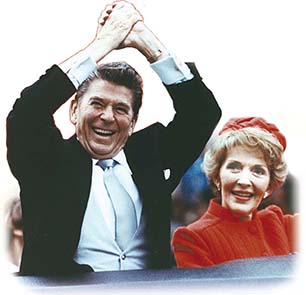SECTION 2: The Reagan Revolution

▲ Ronald Reagan and his wife Nancy after his victory in the 1980 election. Above, a campaign button for Reagan.

WITNESS HISTORY  AUDIO
AUDIO
Reagan’s Vision
During his eight years as President, Ronald Reagan earned a reputation as the “Great Communicator” because of his speaking abilities. In his farewell speech, he expressed his satisfaction with what he had accomplished:
“After 200 years, two centuries, … [America is] still a beacon, still a magnet for all who must have freedom…. We’ve done our part. And as I walk off into the city streets, a final word to the men and women of the Reagan revolution, the men and women across America who for eight years did the work that brought America back. My friends: We did it.”
—Ronald Reagan, Farewell Address, January 11, 1989
Objectives
- Analyze Reagan’s economic policies as President.
- Summarize how Reagan strengthened the conservative movement.
- Evaluate the steps taken to address various problems in the 1980s and early 1990s.
Terms and People
- supply-side economics
- deregulation
- budget deficit
- national debt
- Savings and Loan crisis
- voucher
- AIDS
NoteTaking
Reading Skill: Identify Main Ideas Identify the main ideas behind Reagan’s policies.

Why It Matters Conservatives celebrated Ronald Reagan’s election as the fulfillment of their dreams. Some even referred to his coming to power as the “Reagan Revolution.” The Reagan Revolution would bring a significant shift in the political direction of the nation. Section Focus Question: What were the major characteristics of the conservative Reagan Revolution?
Reaganomics Guides the Economy
Reagan and his advisers based their economic policies on the theory of “supply-side economics,” sometimes called “Reaganomics.” The theory of supply-side economics rests on the assumption that if taxes are reduced, people will work more and have more money to spend, causing the economy to grow. The government will then collect more in taxes. To cut taxes while still balancing the federal budget, however, Reagan also needed to reduce federal spending on programs favored by both Democrats and Republicans.
New Policies to Boost the Economy
Congress approved most of Reagan’s plan to institute supply-side economics by passing the Economic Recovery Act of 1981, which reduced taxes by 25 percent over three years. The richest Americans received the largest tax cuts. Reagan justified this move by saying that the wealthy would use the money they saved to invest in new businesses, which would




